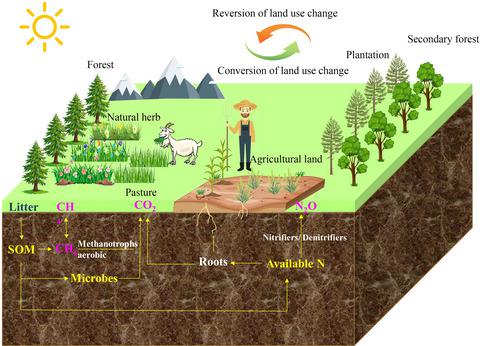当前位置:
X-MOL 学术
›
Glob. Change Biol.
›
论文详情
Our official English website, www.x-mol.net, welcomes your feedback! (Note: you will need to create a separate account there.)
Responses of soil greenhouse gas emissions to land use conversion and reversion—A global meta-analysis
Global Change Biology ( IF 11.6 ) Pub Date : 2022-08-05 , DOI: 10.1111/gcb.16370 Zhaohui Feng 1 , Lingqing Wang 1 , Xiaoming Wan 1 , Jun Yang 1 , Qin Peng 1 , Tao Liang 1 , Yazhu Wang 2 , Buqing Zhong 3 , Jörg Rinklebe 4, 5
Global Change Biology ( IF 11.6 ) Pub Date : 2022-08-05 , DOI: 10.1111/gcb.16370 Zhaohui Feng 1 , Lingqing Wang 1 , Xiaoming Wan 1 , Jun Yang 1 , Qin Peng 1 , Tao Liang 1 , Yazhu Wang 2 , Buqing Zhong 3 , Jörg Rinklebe 4, 5
Affiliation

|
Exploring the responses of greenhouse gas (GHG) emissions to land use conversion or reversion is significant for taking effective land use measures to alleviate global warming. A global meta-analysis was conducted to analyze the responses of carbon dioxide (CO2), methane (CH4), and nitrous oxide (N2O) emissions to land use conversion or reversion, and determine their temporal evolution, driving factors, and potential mechanisms. Our results showed that CH4 and N2O responded positively to land use conversion while CO2 responded negatively to the changes from natural herb and secondary forest to plantation. By comparison, CH4 responded negatively to land use reversion and N2O also showed negative response to the reversion from agricultural land to forest. The conversion of land use weakened the function of natural forest and grassland as CH4 sink and the artificial nitrogen (N) addition for plantation increased N source for N2O release from soil, while the reversion of land use could alleviate them to some degree. Besides, soil carbon would impact CO2 emission for a long time after land use conversion, and secondary forest reached the CH4 uptake level similar to that of primary forest after over 40 years. N2O responses had negative relationships with time interval under the conversions from forest to plantation, secondary forest, and pasture. In addition, meta-regression indicated that CH4 had correlations with several environmental variables, and carbon–nitrogen ratio had contrary relationships with N2O emission responses to land use conversion and reversion. And the importance of driving factors displayed that CO2, CH4, and N2O response to land use conversion and reversion was easily affected by NH4+ and soil moisture, mean annual temperature and NO3−, total nitrogen and mean annual temperature, respectively. This study would provide enlightenments for scientific land management and reduction of GHG emissions.
中文翻译:

土壤温室气体排放对土地利用转换和恢复的响应——一项全球荟萃分析
探索温室气体(GHG)排放对土地利用转变或回归的响应对于采取有效的土地利用措施缓解全球变暖具有重要意义。进行了一项全球荟萃分析,分析了二氧化碳(CO 2)、甲烷(CH 4)和一氧化二氮(N 2 O)排放对土地利用转换或恢复的响应,并确定了它们的时间演变、驱动因素、和潜在的机制。我们的研究结果表明,CH 4和N 2 O 对土地利用转换呈正响应,而CO 2对天然草本和次生林向人工林的变化呈负响应。相比之下,CH 4对土地利用归还反应消极,N 2 O对农用地归还森林也表现出消极反应。土地利用转换削弱了天然林和草地作为CH 4汇的功能,人工人工加氮增加了N 2 O从土壤中释放的N源,而土地利用转换可以在一定程度上缓解这种情况。 . 此外,土地利用转变后土壤碳对CO 2排放的影响将长期存在,次生林40多年后达到与原始林相近的CH 4吸收水平。氮2在森林向人工林、次生林和牧场的转变下,O响应与时间间隔呈负相关。此外,元回归表明CH 4与多个环境变量存在相关性,碳氮比与N 2 O排放对土地利用转换和恢复的响应呈相反关系。驱动因子的重要性表明CO 2、CH 4和N 2 O对土地利用转换和恢复的响应易受NH 4 +和土壤湿度、年平均气温和NO 3 -的影响。,总氮和年平均温度,分别。本研究将为科学土地管理和减少温室气体排放提供启示。
更新日期:2022-08-05
中文翻译:

土壤温室气体排放对土地利用转换和恢复的响应——一项全球荟萃分析
探索温室气体(GHG)排放对土地利用转变或回归的响应对于采取有效的土地利用措施缓解全球变暖具有重要意义。进行了一项全球荟萃分析,分析了二氧化碳(CO 2)、甲烷(CH 4)和一氧化二氮(N 2 O)排放对土地利用转换或恢复的响应,并确定了它们的时间演变、驱动因素、和潜在的机制。我们的研究结果表明,CH 4和N 2 O 对土地利用转换呈正响应,而CO 2对天然草本和次生林向人工林的变化呈负响应。相比之下,CH 4对土地利用归还反应消极,N 2 O对农用地归还森林也表现出消极反应。土地利用转换削弱了天然林和草地作为CH 4汇的功能,人工人工加氮增加了N 2 O从土壤中释放的N源,而土地利用转换可以在一定程度上缓解这种情况。 . 此外,土地利用转变后土壤碳对CO 2排放的影响将长期存在,次生林40多年后达到与原始林相近的CH 4吸收水平。氮2在森林向人工林、次生林和牧场的转变下,O响应与时间间隔呈负相关。此外,元回归表明CH 4与多个环境变量存在相关性,碳氮比与N 2 O排放对土地利用转换和恢复的响应呈相反关系。驱动因子的重要性表明CO 2、CH 4和N 2 O对土地利用转换和恢复的响应易受NH 4 +和土壤湿度、年平均气温和NO 3 -的影响。,总氮和年平均温度,分别。本研究将为科学土地管理和减少温室气体排放提供启示。



























 京公网安备 11010802027423号
京公网安备 11010802027423号